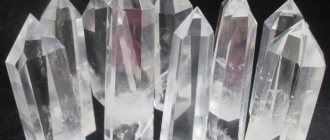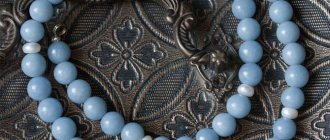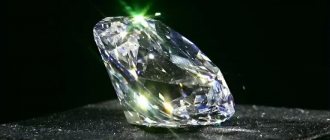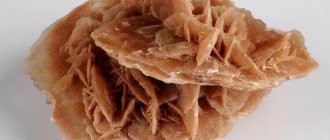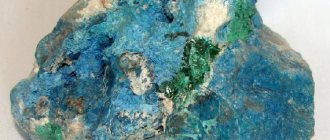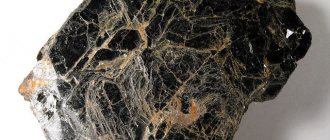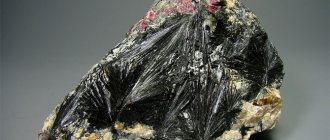| Category | Phosphates (minerals) |
| Title in English | Apatite |
| Formula | Ca5[PO4]3 |
| Group | Mineral group |
| Color | White, Green, Blue-green, Light Blue, Purple, Red |
| Stroke color | White to yellowish gray |
| Shine | Glassy to greasy |
| Transparency | Transparent, Translucent to Opaque |
| singonia | Hexagonal |
| Hardness | 5 |
| Cleavage | Imperfect |
| Density, g/cm³ | 3,2 — 3,4 |
| Kink | Conchoidal |
| origin of name | Apatite is a derived name from the Greek word ἀπατάω, which translates as “deception.” Such an interesting name was given due to the fact that the semi-precious stone can easily be confused with amethyst, tourmaline, topaz, beryl or diopside. |
| Morphology | The most common form of apatite occurs as prismatic, pre-acicular crystals. However, tabular forms are also noted. |
The geological concept of “blende” is associated with rocks that imitate various nuggets. One of these “ardent deceivers” is apatite, as even the name of this mineral indicates. It contains calcium phosphate and pure calcium, which together form beautiful and regular geometric crystals of large sizes, similar to precious gems. Apatite aggregates can weigh hundreds of kilograms! But not all stones are suitable for jewelry. Small transparent crystals are considered the highest quality. And only a few of them are pure enough and suitable for cutting and making jewelry.
Apatite deposits
Large deposits of apatite are rare.
The largest known one is located on the Kola Peninsula (Russia), where there are deposits of apatite ore that contain fluorapatite and nepheline (apatite nepheline ores). Large apatite crystals (moroxites) are mined in Transbaikalia. — Advertising —
In addition, apatite is mined in countries such as Brazil, Mexico, USA, Chile, South Africa, Finland, Spain, and Norway.
Minerals of the Kola Peninsula. Apatite
As you know, the Kola Peninsula is extremely rich in a variety of minerals and minerals. About 500 minerals have been found on the territory of the Khibiny massif, dozens of which are of practical value, 110 are not found anywhere else. Such a concentration of a huge amount of minerals in a limited area has no analogues anywhere in the world. And we have already met representatives of the Kola ores - tinguaite and natrolite. Today I want to introduce you to the mineral that gave its name to the city-scientific capital of the Arctic.
Stone-sea, stone-water.
Apatite (from ancient Greek “I deceive”) is a mineral of the phosphate class, usually pale greenish, blue, yellow-green or pink in color with a glassy sheen. The name of the mineral is due to the fact that it occurs in nature in different forms, so it was often confused with other minerals (beryl, diopside, tourmaline).
Apatite is one of the most common accessory minerals. In igneous rocks it can be one of the first to begin to crystallize, and continue until crystallization is complete, often already at the intercumulus stage. Druses of crystals are often found in miaroles in granite pegmatites, and in sedimentary rocks - in the form of rounded grains.
A characteristic mineral of carbonatites and lamprophyres. In these rocks it can be a xenocrystal, and come from both the mantle and crustal rocks, or crystallize directly from the melt.
Apatite is one of the most common biominerals. Its microcrystals are found in the teeth and bones of vertebrates and humans. It is found in all forms of life - bacteria, invertebrates and plants.
Apatite deposits are numerous. The largest industrial deposit is in Russia on the Kola Peninsula in rocks of the alkaline complex (Khibiny massif). Also the Kovdor field, Sev. Karelia, Slyudyanka (Baikal region), Yakutia, East. Siberia. Kazakhstan.
Apatite from Slyudyanka
The term “apatite” was introduced into use in 1788 by A. Werner. Apatite, a calcium phosphate, usually occurs as solid granular masses. Less commonly, individual prismatic crystals are found embedded in the rock. Opaque crystals can reach enormous sizes. For example, apatite prisms weighing more than 200 kilograms and about 2 meters long were discovered in Canada.
Jewelry apatites are found in deposits of various countries. Blue apatites are known in Burma, Brazil, Sri Lanka, Finland; blue-green - in Norway; green - in India, Canada, Mozambique, Burma, Madagascar; yellow - in Mexico, Canada, Brazil; brown - in Canada; purple - in Germany, Czechoslovakia, USA (Maine, California); colorless - Burma, Italy, Germany; with a cat's eye effect - in Sri Lanka and Burma. In Russia, jewelry apatites were found on the Kola Peninsula and in Transbaikalia - blue, in Eastern Transbaikalia and in the Pamirs - pink, in Aldan - green.
Transparent, beautifully colored apatites are used as a jewelry stone, which requires careful handling due to its rather low hardness - 5. But such jewelry stones are very rare. Jewelry apatites are quite small in size - usually up to 5 carats, occasionally up to 20 carats. Large golden-green stones weighing 147 carats were found in Kenya, and flawless stones weighing 100 carats were processed in Canada.
The color of apatite is associated with numerous impurity elements that make up the mineral. During processing, apatite is given a facet cut; less transparent stones are cabochonized. Other types of stone, due to the high phosphorus content in their composition, are used in various industries.
Esotericists and lithotherapists believe that blue apatites are able to cool raging emotions and cause the owner to have a peaceful and slightly drowsy state. It is no coincidence that apatite is called the stone of peace. Green apatite promotes a good mood and the development of an optimistic point of view.
It is believed that yellow apatite can have a beneficial effect on the entire body. Together with rock crystal, blue or colorless apatite crystals can be used to harmonize physical condition; in this way they are similar to rock crystal. Apatite is a neutral stone and is not capable of harming its owner.
This concludes our story about apatite, but there is still a lot of interesting things ahead of us! Thanks for your attention, stay on the line. 
History of apatite
The first scientific description of apatites was made at the end of the 18th century by the scientist A.G. Werner, who proposed a name for the stone. The word “apatite” is of ancient Greek origin and is translated as “I deceive.” It indicates that natural apatite is extremely diverse and can superficially resemble other stones, such as beryl, diopside and tourmaline. A diagnostic feature of apatite is the prismatic shape of its crystals and relatively low hardness.
Origin and location
Apatite with nepheline and sphene Kola Peninsula
Magmatic - in alkaline rocks, together with nepheline, is one of the main rock-forming minerals (in nepheline syenites) and forms the most important industrial type of apatite deposits; in acidic rocks it occurs as an accessory mineral. Pegmatite - in veins with muscovite. Metamorphic - in skarns, which are associated with the largest and well-cut apatite crystals, as well as in gneisses and schists.
Members of the apatite group are the most common and most widely distributed of all phosphorus-containing minerals. The most important members of the group are fluorapatite and fluorohydroxylapatite, together with their carbonate varieties, while substantially pure chlorapatite, carbonate apatite and hydroxyapatite are rare and of limited distribution. Fluorine-containing types occur in almost all igneous rocks as early-forming accessory minerals, usually in microscopic crystals, and may occur as exceptionally large masses as late igneous segregations in alkaline igneous rocks (Kola Peninsula). Apatite is also found crystallized in pegmatite facies of both felsic and mafic igneous rock types; in magnetite deposits; in hydrothermal veins, especially those formed at high temperatures, and in alpine-type veins. Apatite is quite common in both regionally and contact-metamorphosed rocks, especially in crystalline limestones, where it occurs together with sphene, zircon, pyroxene, amphibole, spinel, vesuvian, and phlogopite; also in talc and chlorite Shales; as a contact-metamorphic mineral; also in extensive strata deposits of marine origin and in the residual or detrital deposits derived from them; as a product of the replacement of limestone or coral by phosphate solutions formed by leaching of guano deposits.
Physico-chemical characteristics of apatite
In terms of their chemical composition, apatites belong to mixed calcium phosphates.
As additional elements, apatite often contains fluorine, chlorine, manganese, iron, strontium, aluminum, thorium, and rare earth elements. — Advertising —
The shape of the mineral crystals is varied: from prismatic to needle-shaped, less often short-columnar or tabular. Apatites are characterized by the presence of granular sugar-like aggregates, dense masses, radial and columnar aggregates. The fine-fiber structure is much less common.
Pure apatite crystals are colorless, completely transparent or translucent. Their color depends on the composition of impurities, for example, iron gives the mineral a smoky or yellowish tone, blue and green apatites contain manganese and lead.
The gem is characterized by the manifestation of luminescence, due to which it changes its color from different viewing angles. Blue and yellow examples are often decorated with a cat's eye effect.
The hardness of apatite on the Mohs scale is 5, which is quite low for jewelry processing and requires careful handling of the stone.
Chemical composition
Several minerals from the phosphate class are called apatite. The formula of the compound forming the mineral is Ca10(PO4)6(OH, Cl, F)2. The most famous are three types: hydroxo-, chlorine- and fluorapatite. Depending on this, the above formula will change. The content of calcium oxides (CaO) and phosphorus is about 53-56% and 41%, respectively. The remaining insignificant proportion is fluorine, chlorine, sometimes carbonate, as well as various impurities.
In its pure form, apatite has no color. Impurities give various pale shades to the mineral. For example, manganese in various combinations colors crystals pink, purple, greenish-yellow, neodymium and iron give yellow and smoky tones.
Magical properties of apatite
All owners of jewelry and talismans with apatite are guaranteed to prevent serious upheavals in life.
This gem causes prophetic dreams to appear; it endows its owner with insight and a strong intuitive awareness of dangerous situations. Interestingly, if the stone is worn on the body, it begins to behave very actively. For example, when danger approaches, the skin that comes into contact with the stone begins to become irritated, itchy and red. And if at the same time there is a desire to get rid of the decoration, it means that the danger has reached its maximum. Still, it’s not worth parting with apatite. It is believed that when a stone is separated from its owner, it loses all its properties and becomes a dull and colorless piece of rock.
But apatite cannot damage, so it has never been used in black magic rituals.
Caring for products with stone
The mineral is characterized by low hardness, chemical instability, and fragility, so jewelry makers and product owners have to handle the stone very carefully. Environmental influences are dangerous for him:
- The crystal becomes dull from the usual wiping of dust from it.
- Mechanical stress causes chips and scratches.
- The gem is rinsed with heated water and gently wiped.
- The mineral does not tolerate high temperatures.
Also read: Dumortierite - the secret of good luck and longevity
Given the delicate structure of the stone, it is stored separately from other products, wrapped in soft cloth.
Healing properties of apatite
For the healing properties of apatite to manifest, it must be combined with other healing minerals.
For example, crystals of yellow and brown shades in combination with other similar minerals stimulate the heart, and if blue apatites are combined with aquamarines, they will help a lecturer or singer. The harmonization of the human condition is facilitated by the combination of intensely blue apatites with jewelry made of rock crystal and diamonds.
With the help of green apatites, depression and depressed states are treated. Blue-green crystals have a calming and peaceful effect.
Applications of apatite
Non-gem quality apatite is a raw material in the production of phosphate fertilizers, phosphorus compounds and phosphate acid.
The mineral is used in ferrous and non-ferrous metallurgy, for the production of ceramics and glass. Jewelers use apatite quite rarely, which is due to its low hardness and fragility. Typically, gem-quality apatites barely reach 5 carats, and extremely rarely – 20 carats. As a rule, such samples are an object of collector's interest, especially if they are well cut, translucent and transparent.
Use in agriculture
It has long been known that apatites are fertility minerals, so their main area of application is agriculture. Phosphorus is one of the main components of a chemical compound, as mentioned above. As you know, this element is vital not only for humans, but also for plants. Phosphorus is a building material for living organisms; it takes part in many biological processes.
How to distinguish real apatite from a fake
Apatite itself is not counterfeited, but the gem itself, even the name of which is translated as “deception,” is quite often confused with tourmalines, topazes, beryls, amethysts, diopsides and aquamarines. The main difference between apatite and precious and semi-precious stones is its low hardness.
Prices for apatite products
Considering the varied properties and quality of apatites, their prices also vary widely. For example, transparent, clean samples with a beautiful cut are valued at $2-3 per carat. Heterogeneous stones with defects are valued much lower. Beads are often made from them. The cheapest specimens of apatite are those that are ground into cabochons. Such stones are opaque and layered. Pendants and other small jewelry are made from fractured apatites, the cost of which is very low.


